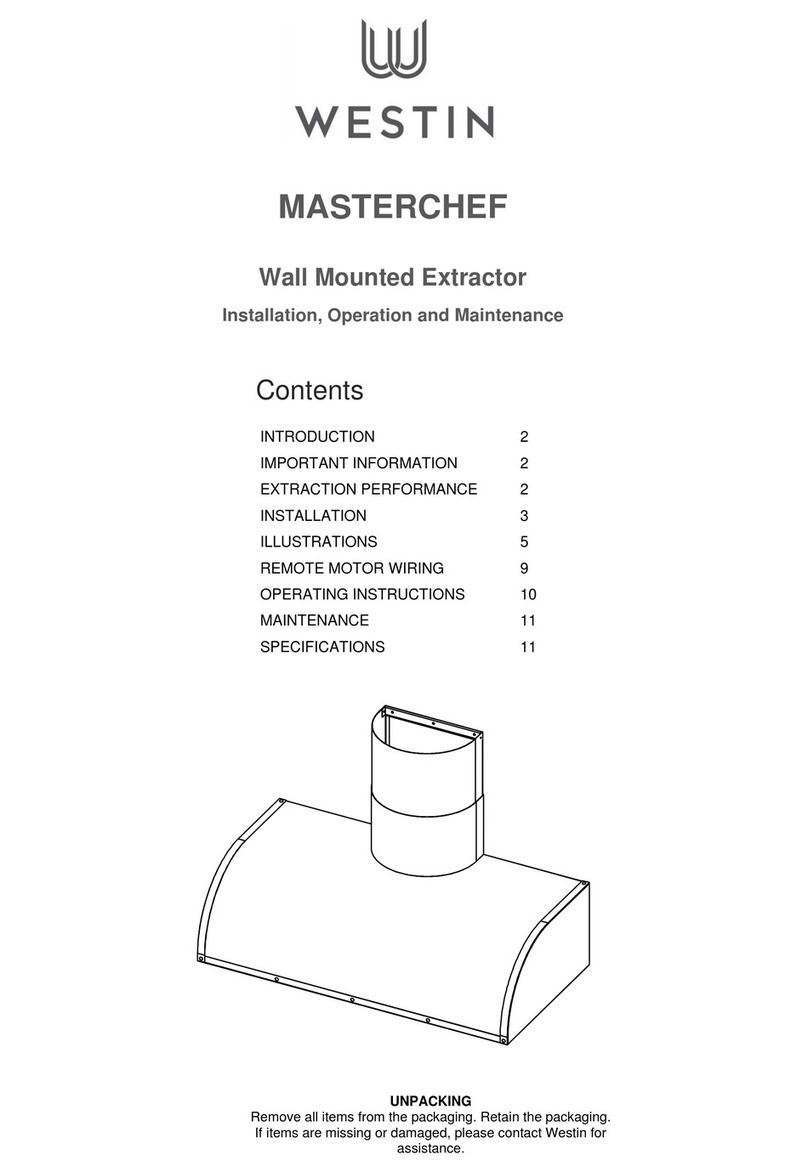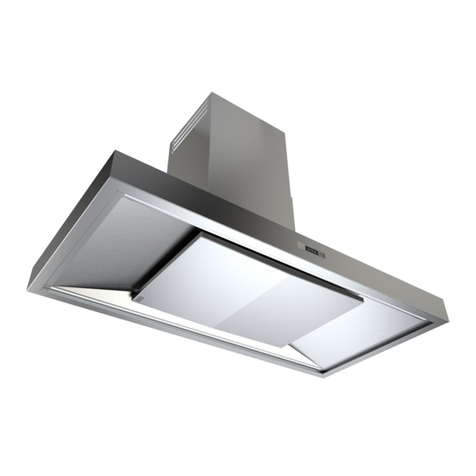
Ceiling Built-in Unit
Installation, Operating & Maintenance Instructions
W1521 WSW STRATUS FLUSH Ceiling Extract O&M Sep 16.docx Page 3 Westin
Please note the following.
The extractor is made up of two main parts*:
o The “top box”, which houses the exhaust ducting
spigot, grease filter, electrical connection points and
any internal motor.
o The “baseplate”, which is essentially the visible parts
when installed and houses the lights, hinged filter
concealment panel and outer frame.
The ducting spigot must be set to the required outlet
position prior to installation (Left, Right, Front, Rear or
Top).
The Stratus Flush “top box” has 3 possible duct spigot
positions. It is easily separated from the baseplate and can
be rotated through 180 degrees in order to achieve all 5
possible outlet directions. It is secured via screws
accessible only when the filter concealment panel is in the
open position.
The extractor fixing holes are hidden behind the LED down
lights, which can easily be popped out to reveal four
possible fixing locations behind each (only one fixing hole
in each corner needs to be used).
If your extractor is a recirculating model, (optional extra
and not the standard configuration) then adequate
provision must be made for exhausted air to return into the
kitchen - e.g. ducted out to a vent in the kitchen located
somewhere that minimises uncomfortable draughts onto
occupants. Failure to do so may cause the unit to overheat
and fail (invalidating your warranty).
4.1. Opening the filter concealment panel.
The panel is held shut with magnetic catches.
Open the panel by grasping it close to the corners on the
catch side (the long edge opposite the hinges) and pulling to
release the panel from the magnets. Take care not to let the
panel fall open freely. It should be supported and moved
carefully into the open position.
4.2. Setting the Duct Spigot Position.
Your extractor ducting spigot can be set to vent to the Left
(factory default), Right, Front, Rear or Top.
The front of the unit (when installed) is the side with the
magnetic catches.
Note: If you wish to vent upwards and space is restricted, then
you may find your installation easier if you use a side outlet
position and put a bend in your ducting.
The “top box” exhaust spigot assembly refers to the removable
150mm ducting spigot plate, which in the case of Internal
blower models, has the motor attached to it.
As described earlier, the Stratus Flush “top box” has 3
possible duct spigot positions, with the remainder being
achieved by rotation of the top box through 180 degrees.
To change the exhaust spigot position of the "top box"
proceed as follows:
Suspend the extractor on its back such that the “top box” is
clear of the ground. This is best achieved by placing the
product across the top of the open box it came in so that
the "top box" hangs down into the box.
Open the filter concealment panel and remove the filter(s).
Each exhaust position has 4 captive nuts onto which can
be bolted either the exhaust spigot assembly or a blanking
plate.
Bolt the exhaust spigot assembly into the required location
by swapping it with a blanking plate as necessary using a
screwdriver.
Note: For internal blower models, where space within the
top box is limited, only the screws nearest to the filter
opening need to be fully removed. The screws farthest
away need only to be backed off as the plate has slots for
easier removal/replacement of the motor.
To rotate the "top box" proceed as follows:
Suspend the extractor on its back such that the “top box” is
clear of the ground. This is best achieved by placing the
product across the top of the open box it came in so that
the "top box" hangs down into the box.
Open the filter concealment panel to reveal the fixing
screws securing the “top box” to the “baseplate” and
remove the screws.
Carefully lift the "top box" out of the "baseplate" opening,
rotate it to face the required direction and carefully refit it in
its new position, taking care not to trap any wires. Secure it
with the screws previously removed.
4.3. Revealing the Fixing Holes.
The extractor is fitted with 4 high intensity LED lamp
assemblies (one in each corner) which conceal the fixing
holes behind them. These are easily popped out to reveal four
possible fixing locations behind each.
The best way to remove the lamps for initial installation is to
pop them out from behind. 25mm finger holes (centred on
each lamp) are provided in the baseplate to enable this.
The lamps remain attached to their electrical cables so care
must be taken not to damage the wires during installation.
Note: The fixing holes can be revealed after the unit is
installed by carefully pulling the lamps out from underneath.
Four fixing holes will now be visible in the corner of each lamp
opening.
You should only need to use 1 of the holes in each corner to
secure the unit in position.
4.4. Prepare Opening
Prepare an opening in the ceiling into which the unit will be
fitted (see table below). Refer to the drawings on Page 7 for
detailed opening design and clearance height information.
Unit Size (mm)
(Width x Depth)
Cut-out Size (mm)
(Width x Depth)
900 x 440 860 x 400
1200 x 440 1160 x 400
900 x 800 860 x 760
1200 x 800 1160 x 760
Reinforce the opening as necessary and make suitable
provisions for the screws that will hold the unit in place.
Tip: To avoid the need to box down from the ceiling, consider
the joist direction, ceiling thickness (and possibly lowering the
ceiling slightly). As much of the baseplate only intrudes above
the finished ceiling by 35mm, (see diagrams on Page 7
Onwards) boxing down can usually be avoided with minimal
alterations to the ceiling arrangement.
Important.
The "top box" needs to be angled during removal and
refitting to allow the duct spigot, electrical connection
points and cables to clear the opening in the "baseplate"



































